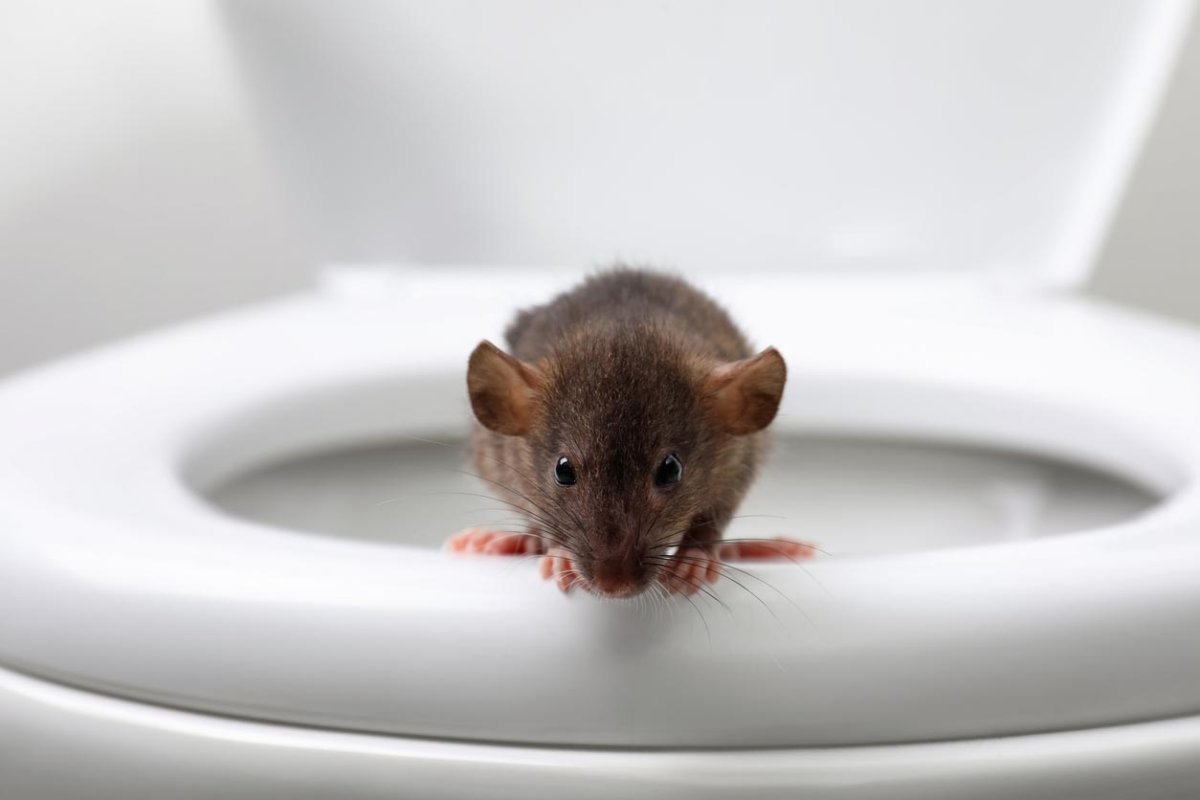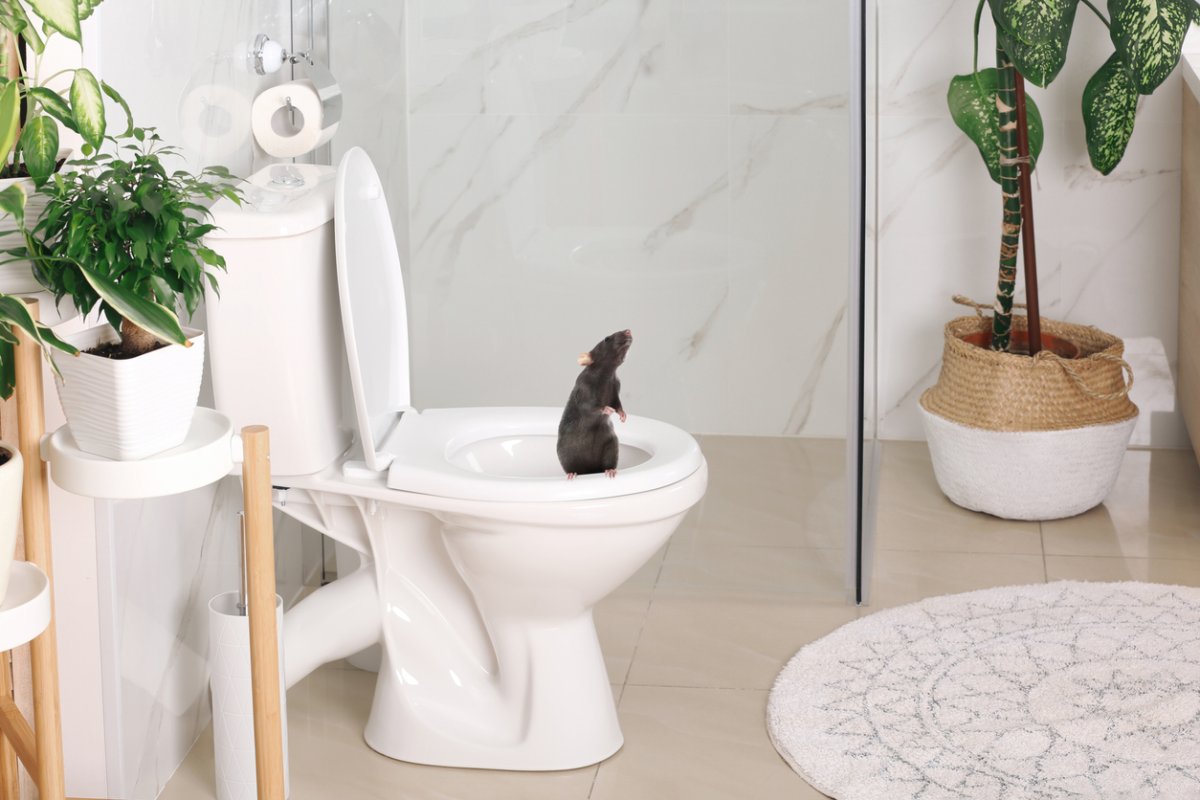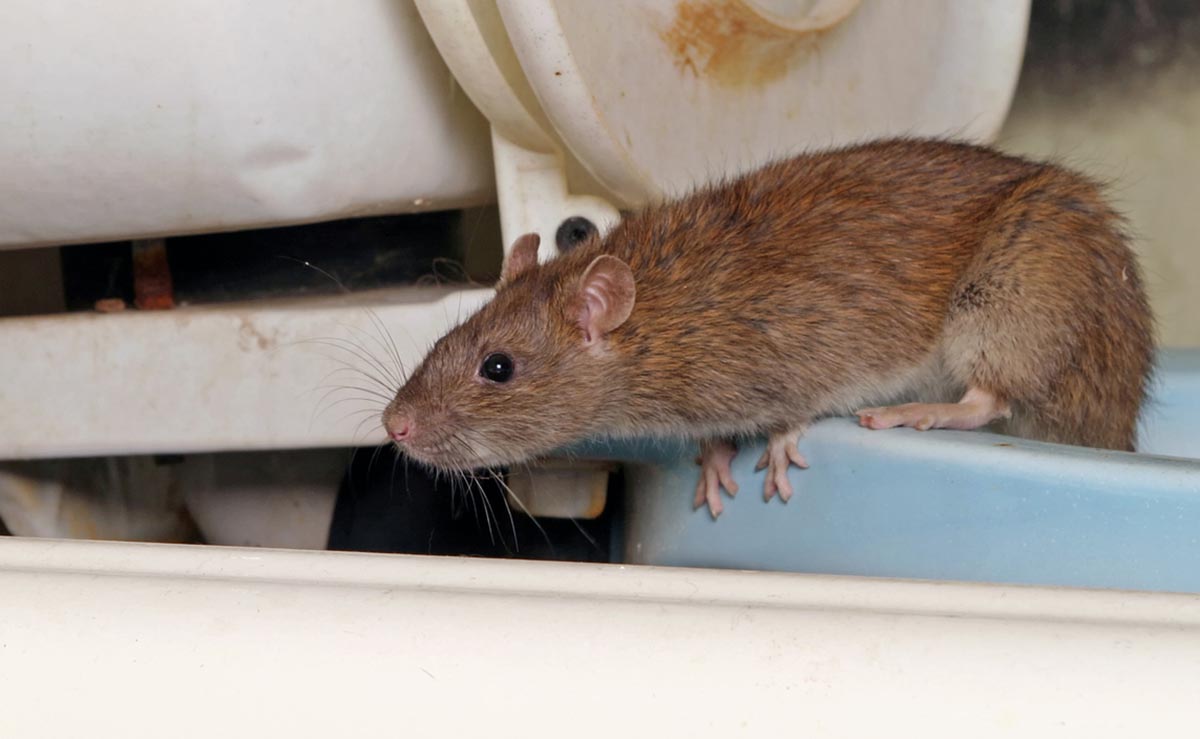

We may earn revenue from the products available on this page and participate in affiliate programs. Learn More ›
Q: I just found a rat in my toilet bowl—I’ve heard of this happening, but I always assumed it was a myth! How do rats come up toilets, and what do I do now? Can I prevent rats in the toilet in the future?
A: It’s not just an urban legend: Rats really can travel through pipes and into the toilet.
A rat coming out of the toilet bowl can be a surprising (and terrifying) discovery that sparks immediate concerns about safety and sanitation. Although it may not be a frequent occurrence, living or dead rats in toilets can indicate a larger issue within urban sewer systems and residential plumbing. James Agardy is a technical and training manager at Viking Pest Control, a company based in Liberty Corner, New Jersey. He adds, “While there is nothing specific to toilets that draws the rats in, once they find their way into the lines toilets can provide [an] easy point of entry for them into the home.”
Those in this situation may immediately wonder what steps can be taken to get rid of the rat and prevent rats from coming back. In short, flushing the rat may be the simplest solution. However, it’s important to assess the situation carefully and consider calling one of the best pest control companies like Orkin or Terminix if the problem is overwhelming.
How (and Why) Rats Come Up Toilets
Rats are often found in sewers, and they are typically drawn to warmth, nesting sites, and potential food sources. However, if competition for food is high, sewer rats may follow the scent of kitchen scraps straight into a home’s plumbing system. Rats have hinged rib cages that allow them to squeeze through small gaps or cracks inside sewage pipes. According to Agardy, “Rats are excellent at running, jumping, climbing, and swimming and use these abilities to gain access to drain lines. They can swim great distances and can even dive beneath the surface to enter pipes. In addition to working their way up from the sewer system, [rats] can gain access to the system by entering plumbing vent stacks and working their way in from the top down.” Although rats can be found in toilets in any environment, urban areas are particularly susceptible, as the dense network of sewer pipes and connections to residential buildings are ideal for rats climbing to explore new territories.

What to Do After Finding a Rat in the Toilet
For those who have had the misfortune of finding a rat in the toilet, or would like to be prepared for this possibility, there are a few safe and effective steps for resolving this problem.
If the rat is still alive, it’s important to keep the toilet lid closed.
In the unsettling event that a resident discovers a rat in their toilet that is still alive, it’s important to keep the toilet lid firmly closed. This will prevent the rat from jumping out of the toilet and traveling elsewhere in the home where it cannot be easily removed. Placing a heavy object on the toilet lid will prevent the rat from pushing its way out and into the bathroom. Containing the rat within the toilet buys plenty of time to assess the situation calmly and decide on next steps, whether that is contacting pest control professionals or taking a DIY approach. There is also a slight chance that once the rat realizes it is stuck, it will exit the toilet the same way it entered.
Squirting a small amount of dish soap into the toilet bowl will make it harder for the rat to stay afloat, causing it to drown.
A dead rat in the toilet is much safer and easier to deal with than a live one. Dish soap is a surprising ingredient that can be used to quickly kill rats in water. Because dish soap is a degreaser, it will remove any oil from the rat’s fur or skin that is helping it to stay afloat. It will also cause the water’s surface tension to break, further inhibiting the rat’s ability to tread water. Eventually, the rat will tire and drown. At this point, there is no longer a risk of the rat escaping from the bowl or biting and scratching residents. Being slippery from the dish soap will also help the rat flush more easily down the toilet if that is the next step a resident chooses to take.
Once the rat is dead, it may be possible to flush it back down the toilet.
The most obvious course of action to address a rat stuck in the toilet is to flush it, ideally if it’s already dead. Agardy warns, “It’s possible the water pressure can flush it back down the lines, but rats are strong swimmers so flushing may not be effective. Flushing the rat can also cause a blockage in the line that will need to be cleared.” Rats that were small enough to crawl up the toilet plumbing in the first place can often be flushed back down with relative ease. However, larger rats may cause plumbing blockages, disrupting the normal flow of waste or leading to more significant plumbing problems requiring professional repair. In the event of a clog from a flushed rat, it’s best to call one of the best plumbing services (such as Mr. Rooter or Roto-Rooter) to remedy the issue.

If the rat escapes from the toilet bowl or is too big to flush, it’s best to call a pest control company for assistance.
For those who encounter a situation where a rat in a toilet bowl escapes, or who suspect the rat is too large to be safely flushed, professional assistance will be the best route for the rat’s removal.
It may be possible to catch a rat that escapes from the toilet using one of the best rat traps. However, it’s worth knowing that according to the Centers for Disease Control and Prevention (CDC), rats are known carriers of various diseases such as hantavirus. These diseases can be transmitted through direct contact, such as attempting to capture or dispose of the rat, or indirectly through exposure to environments contaminated by rodent urine, droppings, or saliva. Pest control companies will be equipped with the necessary tools, knowledge, and protective gear to safely remove a rat without risking the spread of diseases within the home. The cost to exterminate rats is about $176 to $580 on average.
Although the cost of pest control is not insignificant, it can provide great peace of mind to residents who aren’t prepared to deal with a rat issue on their own. Pest control professionals may also be able to provide solutions to prevent rats and other pests from entering the home in the future.
How to Prevent Rats in Toilets
According to Agardy, “While keeping rats out of sewer and drainage systems is not feasible, the good news is that yes, there are things that can be done to keep them from entering the home.” Cleaning kitchen drains with baking soda and vinegar, or hiring one of the best drain cleaning services, can reduce food smells that attract rats to a home in the first place. Bleach and peppermint oil can also be helpful (albeit temporary) deterrents for keeping rats and mice away from a home’s toilets. Although bleach has a strong odor initially, its effectiveness on rats is short-lived once the scent dissipates. Peppermint oil may be a safer home rat repellent due to its strong scent, but like bleach, it won’t be effective once the scent wears off.
Finally, a plumbing inspection costs $200 on average. It can reveal any damage that’s making the home’s sewage system vulnerable to rats before they have a chance to enter. For complete rat prevention, some home maintenance projects may be in order. Homeowners may need to have a plumber cap drain covers, install rat blockers, replace damaged pipes, or seal up gaps and cracks where rats can climb inside to enter the home. “Plumbing vent stacks can be screened at the ends to deny rats access from this point,” says Agardy. He also recommends installing check valves, which are “installed in the line and have a door inside them. The water flow will open the door allowing the waste to continue down the system while preventing the flow (or rodent) from traveling back up the other direction as the internal door closes once the flow has stopped.”
